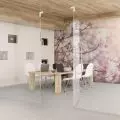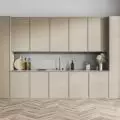The "I HAVE A HOME" project, created by Julia Zubka as part of her master's thesis in the Interior Design Studio under the direction of Prof. Beata Szymańska and Dr. Pawel Czarzasty, is a concept for a communal space serving as ameeting and support place for the elderly and young mothers with children in the Strzyża district of Gdansk. The idea behind the project was to create a space that integrates two separate social groups, promoting solidarity, mutual assistance and building intergenerational relationships that enrich the local community.
facades
© Julia Zubka
integration and social support
The main goal of the project was to create a space that not only provides shelter and social support, but above all enables social activation and the building of close ties between young and old. "I HAVE A HOME" is not just a place to live; it is a living space where seniors and senior citizens and young mothers with children can spend time together, develop their skills and gain new experiences. The designed house is intended to create conditions for mutual support and cooperation.
cross section
© Julia Zubka
modernization
The project envisages modernization of the already existing building, taking into account its expansion and architectural changes, such as adding a floor and adjusting the form of the roof to a gabled one to fit in with the character of the local architecture. The new building form was based on a detailed analysis of neighboring architectural structures and the axes defined by nearby streets. The chosen form of the roof, which harmonizes with the ridges of neighboring buildings, makes it possible to create a building that is in harmony with the architectural climate of the neighborhood, and at the same time stands out for its modern aesthetics.
home
© Julia Zubka
common space
The central part of the building was designed with the common space in mind, which plays a key role in the integration of male and female residents. The kitchen is located here, which is the heart of the house and serves as a place for communal cooking and culinary learning. The dining room is a place for meetings and meals, a space for daily natural contact and relationship building.
The living room, featuring a centrally located fireplace, was designed to create a space of rest and relaxation for all residents. It has been divided into two zones - one for seniors and the other for mothers with children - which makes it possible to spend time in one's own company, but also promotes meetings, joint games and activities that integrate both groups.
kitchen
© Julia Zubka
library and gardener's room
Another important common area is the library, which provides a quiet place to relax, study and reflect, which is especially important for seniors and senior citizens, as well as young mothers. The space can also serve as a place to socialize, develop literary interests or organize thematic workshops that support integration and personal development of residents.
An equally important common space is the Gardener's Room, with direct access to the garden. This room provides opportunities for pursuing interests related to nature and gardening, enabling joint care of plants and organizing educational activities for children in a friendly natural environment. Thanks to this space, both elderly people and young mothers and their children can find outdoor activities and develop their passions in contact with nature.
gardener's room
© Julia Zubka
psychological and legal support zone
The "I've got a HOME" project also includes a separate psychological and legal support zone, which addresses the specific needs of both social groups. In this part of the building, residents can benefit from the assistance of specialists, which is particularly important both for seniors who may have a need for support in health or legal matters, and for young mothers who may need psychological support or legal advice on issues related to raising and caring for children.
Library
© Julia Zubka
comfort for young mothers
The first floor of the building was designed to provide intimacy and comfort for young mothers and their children. There are four living rooms here, serving as small apartments. Each room is equipped with a kitchenette, bathroom and relaxation space, allowing mothers to maintain their privacy and provide a sense of security, even when sharing space with other residents of the house.
However, the privacy of these spaces is not a barrier to social support. With the presence of other mothers and seniors, young women can count on help and share experiences, which creates a supportive parenting environment and fosters integration with the rest of the residents.
In addition, there is a space on the first floor dedicated to a playroom. This space serves as a play and skill development area for children, who are free to explore new interests here. This room is also a place where mothers can find a moment to relax and unwind, knowing that their children are safe and having fun in a controlled environment.
bedroom
© Julia Zubka
Dutch inspiration for intergenerational integration
Julia Zubka's project "I have HOPE" was inspired by Dutch models of social support, promoting activation and integration of different generations. Dutch solutions have shown that coexistence of elderly people with young mothers can significantly improve the quality of life of both groups, creating conditions conducive to mutual support and sharing of experiences. In her project, the young architect adapted this model, creating a space that facilitates strong social ties and promotes intergenerational coexistence in the spirit of mutual assistance.
















































